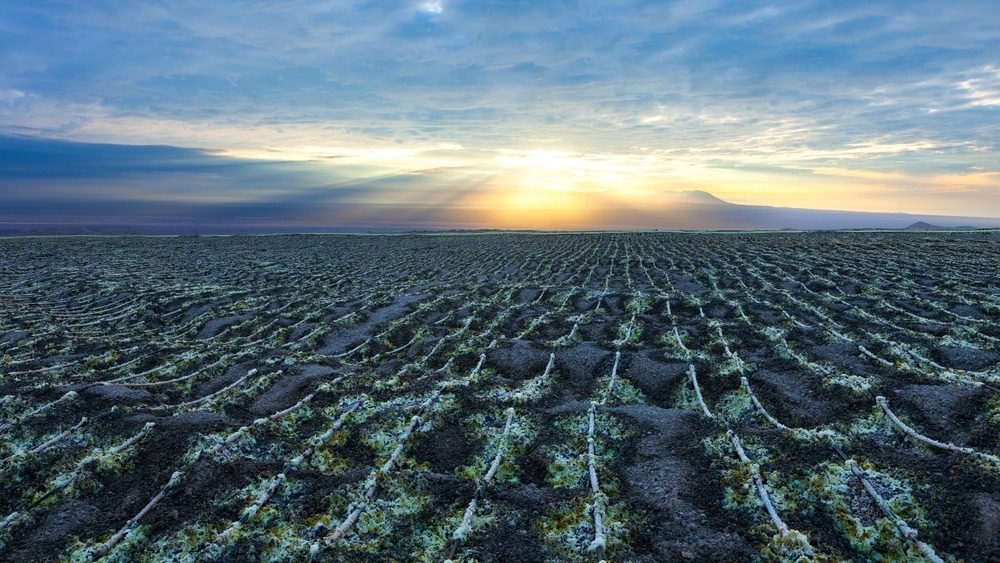In a recent article published in Remote Sensing, researchers from the United States of America employed hyperspectral imaging (HSI) to map heap leach pads, detecting features such as lixiviant ponds, clay minerals, precipitation, and irrigation pipes. This technology is based on light interaction with objects, where photons are absorbed, transmitted, emitted, or reflected, influenced by the object's grain size, atomic composition, and chemical bonds.

Image Credit: Jose Luis Stephens/Shutterstock.com
Background
Leaching is a metallurgical process in which a specific solvent permeates a pile of stacked ore to dissolve valuable elements. This method is favored for its cost-effectiveness and straightforward technology, particularly in copper mining, accounting for 21% of copper extraction globally.
Mining companies traditionally monitor and model leach pads over their lifespan using methods to gather information such as clay content, P80, raffinate distribution, agglomeration effectiveness, and locations of plugged pipes. While these traditional methods are simple and inexpensive, they often yield discontinuous and inefficient data, underscoring the need for more advanced approaches.
The Current Study
The spectral library used in this study comprised two primary components. The first component consisted of spectral signatures from kaolinite, muscovite, biotite, chlorite, epidote, hornblende, enstatite, water with swelling clay, and montmorillonite. The second component included ground truth samples collected during fieldwork, representing irrigation pipes and precipitates found on the leach pad.
To ensure consistency within the reference spectra, the irrigation pipes and precipitates were scanned using an ASD TerraSpec analyzer at the University of Arizona, Tucson. X-Ray Diffraction (XRD) analysis identified the precipitates as hexahydrite (MgSO4·6H2O) and pickeringite (MgAl2(SO4)4·22H2O).
Hyperspectral imagery was captured covering a wavelength range from 400 to 2500 nm, comprising 270 bands for VNIR and 170 bands for SWIR. Principal Component Analysis (PCA) was employed to reduce data dimensionality while preserving spectral information, helping to identify the minimum number of endmembers needed. The HySime method was also used to estimate virtual dimensionality by selecting eigenvectors that best represent the signal subspace, optimizing for mean square error between signal projection error and noise projection.
The N-FINDR algorithm was used to identify endmembers within the hyperspectral images. N-FINDR iteratively evaluates different spectra to maximize the volume of the endmember matrix. The algorithm selects the spectra that produce the highest volume, representing the endmembers.
The abundance maps were generated using fully constrained least squares (FCLS) linear unmixing. The linear regression model represents a pixel as a combination of endmembers with associated abundances, adjusted by a noise term. The FCLS approach adds a Lagrange multiplier to enforce the abundance sum constraint, ensuring that the calculated abundances accurately represent the material distribution in the study area.
Results and Discussion
The analysis indicated that at least five endmembers are necessary due to significant variance captured by the first few components. HySime initially suggested eight endmembers before smoothing and only one afterward, the latter being unrealistic. Therefore, 10 endmembers were selected for N-FINDR analysis, considering the diverse SWIR-active mineral groups and other features on the leach pad.
N-FINDR identified 10 endmembers with generally low reflectance due to wet conditions. EM1, likely water, showed high abundance, suggesting a mixture of water and background. EM2 was identified as irrigation pipes with montmorillonite. EM3 and EM4 represented soaked mineral mixtures, EM5 resembled EM2 but with stronger plastic features, and EM6 was a mixture of chlorite and sulfate precipitate. EM7 combined pipes and kaolinite dust, while EM8, like EM2 and EM5, was affected by noise. EM9 and EM10 were wet precipitates with muscovite and clinochlore, respectively.
PCA provided significant insights: the first component highlighted mineral-related arc patterns from ore loading, and the third showed irrigation pipes. Virtual dimensionality methods performed poorly, with discrepancies between pre- and post-smoothing results. Smoothing reduced variance and suggested fewer endmembers than expected due to moisture's homogenizing effect on the ores.
Some abundance maps were useful despite data quality issues like noise and water content affecting reflectance. EM1's moisture distribution map could help adjust irrigation rates and detect low permeability areas. EM2, EM5, and EM8 highlighted irrigation pipes, aiding in maintenance.
Using ground truth libraries (red pathway) for unmixing provided more reliable results than endmember extraction. This method better captured horizontal pipelines, mineral distributions, and montmorillonite near ponds. It reflected an abundance of materials consistent with mining processes, although differences from surveys were noted due to sulfuric acid effects and spectral changes from ore processing.
Conclusion
This study revealed hyperspectral imaging can directly measure clay content and moisture distribution. Yet, N-FINDR yielded unrealistic water amounts and misclassified minerals. Conversely, using a reference library provided more realistic results but faced challenges in water content estimation and mineral misclassification.
Both techniques offer continuous map data for monitoring, but FCLS with a reference library proved more suitable than N-FINDR for accurate analysis in noisy datasets. Future research should refine methodologies to optimize mining operations further.
Source:
He, J., Riley, D.N., et al. (2024). Is Endmember Extraction a Critical Step in the Analysis of Hyperspectral Images in Mining Environments? Remote Sensing, 16, 2137. https://doi.org/10.3390/rs16122137